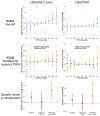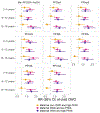Associations of early life per- and polyfluoroalkyl substances (PFAS) exposure with body mass index and risk of overweight or obesity at age 2-18 years: Mixture analysis in the prospective Boston Birth Cohort
- PMID: 39705976
- PMCID: PMC11786237
- DOI: 10.1016/j.envint.2024.109206
Associations of early life per- and polyfluoroalkyl substances (PFAS) exposure with body mass index and risk of overweight or obesity at age 2-18 years: Mixture analysis in the prospective Boston Birth Cohort
Abstract
Background: Per- and polyfluoroalkyl substances (PFAS) are a class of widespread persistent chemicals, which may have obesogenic effects during the fetal period. This study investigated the long-term association of maternal plasma PFAS concentrations at delivery and their mixture with child body mass index (BMI) and the risk of Overweight or Obesity (OWO) at the age of 2-18 years.
Methods: The study included 1189 mother-child dyads from the prospective Boston Birth Cohort. Eight PFAS were measured in maternal plasma samples collected 24-72 h after delivery. Outcomes were BMI Z-score and OWO status of children at 2-18 years. The exposure-outcome associations were evaluated with linear and modified Poisson mixed-effects regression for individual PFAS and Bayesian kernel machine regression and quantile-based g-computation models for PFAS mixture. We explored the effect modification by maternal pre-pregnancy OWO, child age, sex, and race.
Results: Maternal plasma samples had PFAS detection frequencies from 87 % to 100 % and geometric means ranging from 0.11 to 3.67 ng/mL. PFHpS and PFHxS were associated with higher child BMI Z-score. Such associations were stronger in children aged 6-12 years and 13-18 years than in 2-5 years. Stratified by maternal pre-pregnancy OWO, significant associations of the PFAS mixture with child BMI Z-score were only found in children of non-OWO mothers. In children aged 13-18 years, children with both high maternal plasma PFDeA, PFNA, and PFOA concentrations and maternal OWO had the highest risks of OWO compared to children with either only. Such synergistic effects were not found in younger children.
Conclusions: Early life exposure to individual PFAS and their mixture were associated with a higher risk of childhood OWO, with stronger associations observed in older child age groups and in children of non-OWO mothers. Synergistic effects of PFAS exposures and maternal pre-pregnancy OWO became evident in adolescence.
Keywords: BMI; Childhood overweight or obesity; DOHaD theory; Maternal overweight or obesity; PFAS; Prenatal exposure.
Copyright © 2024 The Author(s). Published by Elsevier Ltd.. All rights reserved.
Conflict of interest statement
Declaration of competing interest Dr. Braun has been compensated for services as an expert witness to plaintiffs involved in litigation related to PFAS-contaminated drinking water.
Figures



References
MeSH terms
Substances
Grants and funding
LinkOut - more resources
Full Text Sources

